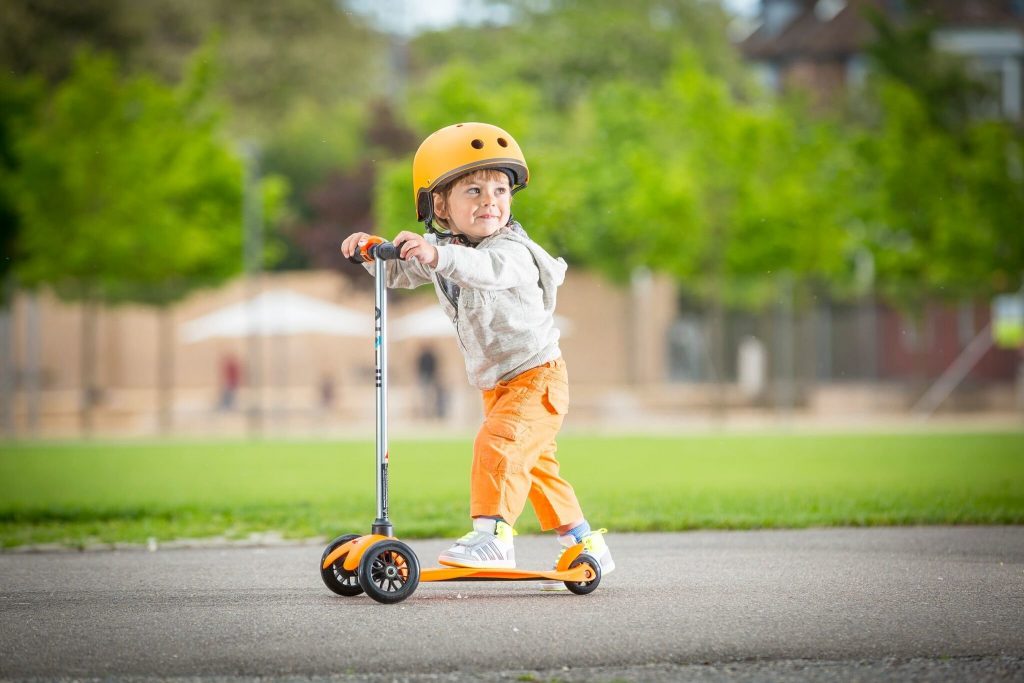My name is Phillip Gray and I love going outdoors riding on skates and scooters. I work as a graphic designer and I love creativity. This is why I appreciate the different creative scooter’s designs. I’ve been riding on kick scooters ever since I was 5 and one of my early scooters had grown-up together with me.
Toddlers and Scooters Safety: What You Need to Know
As parents, we are always excited when our kids learn something new. On the other hand, if our kids are slow learners or lacking confidence, we will do everything to help them cope up with their difficulties.
Like bicycles, kick scooters are one of the most popular riding toys for toddlers to aid them to develop their motor skills. But these rides are not without safety issues. Whether you are buying a 2-wheel or a 3-wheel ride for your kid, there is always a safety issue when your kid is not properly attended to. So, in this article, we are going to guide you on how to properly teach your kid to ride to avoid accidents and other safety concerns.

Are scooters safe for toddlers?
There are two types of scooters for kids and toddlers: the 2-wheel type and the 3-wheel type. The former is intended for kids who are usually 4 years old and above while the latter is for 4 years and younger. Although the latter has 3 wheels, if the kid doesn’t know how to balance or steer, he could hit something that may result in an accident, or he may fall down if not properly attended to by adults.
Although scooters are designed with maximum safety in mind, they can still cause trouble. That’s why as parents, we have to know the basics before letting our kids ride.
In order to avoid any safety issues, we provide the following guide on how to teach your kid to ride.

How do you choose your scooter?
The first thing is choosing a scooter. For starters, several brands offer three-wheeled gear. This is a good option when your child’s balance is still uncertain. You will be reassured. And so is he! Up to 3 or 4 years, these are probably the ideal models. Choose models with two wheels at the front because when placed in the back, the wheels can hinder the foot of the rider when he kicks the ground.
Then you’ll find different sizes tailored to your child’s age. If the rides are done over rather long distances, choose models with larger wheels.
Also, pay attention to the nature of the ground on which your kid will ride. If it is irregular or rough, turn to a model with suspensions, especially at the front, and ergonomic handles to reduce vibrations in the legs and arms.

Protecting your kid well
First of all, you have to be aware that falls are part of learning to ride. In order to limit injuries to a minor, or to avoid injuries at all, it is strongly advised to equip your kid with at least a helmet, but if possible with specific protections for the wrists, knees, and elbows. Elbows and knees are the most common parts of the body to suffer when the rider falls down.
Find the right foot to kick
Your child is standing, his feet are spread over the width of the pelvis. Push it very slightly forward. You will be able to observe which foot your child is advancing to catch up. It will be the foot to put on the board of the scooter first. There are many people who are right-handed but also use their right foot so you better observe closely which foot your kid will be comfortable using when riding.
Alternate foot
You’ve helped your child find his motor foot, that’s important. But once he has better apprehended the machine, you quickly realize that he quickly exhaust himself to the task by staying on the same leg. If he is more in control of the glide, explain to your child that every 3 to 10 kicks (pushed) to the right, he can change his foot. After a few outings, this alternation will come more naturally, because the musculature of his legs will become more symmetrical.
Finding the balance
Once his foot is on the scooter, make sure his little tip keeps his head up, not his eyes on the ground. This instruction will help him to consider the space and the driving will be even more natural. The advantage of the scooter? If he loses his balance, all he has to do is get his foot out! If he is always looking to the ground, he may bump something without his knowing. Like driving, the eyes should always be on the road.

Braking
Riding is good, but braking when necessary is better! There are two ways to brake: with the brake placed on the rear wheel, applying pressure on it, or with the shoe, gently placing the foot on the ground on its side and rubbing its sole to the ground.
Familiarize him with traffic
Another important detail is that in the city, scooters are played on sidewalks. So you need to explain some traffic rules to your children, such as traffic lights and pedestrian crossings. Between passers-by and other gliding enthusiasts, it is important to go slowly, in order to record the information that surrounds it.
Where to ride?
At first, it is best to travel small distances away from cars, whether in a courtyard, on a bike path, or in a busy driveway.
Once the scooter is mastered, he can take it to the city for family walks. He can use it for his daily trips to school or the park for example.

What are the difficulties of scootering?
Achieving a relaxed lifestyle is one of the first difficulties. A lot of people have too stiff legs, which will make them tired faster. On the other hand, the alternation between the two feet can be a problem.
Basic but important safety tips on scooters
- Choose sturdy, high-quality, and branded equipment
- Pay attention to speed: the braking system does not allow you to stop cleanly.
- In case of rain, there is no grip on the ground because the wheels of a scooter are hard.
- Don’t be cluttered with too many bags that could change your balance
By applying the above guidelines when you train your toddler to ride, you will be assured that safety will be a minimal concern.






